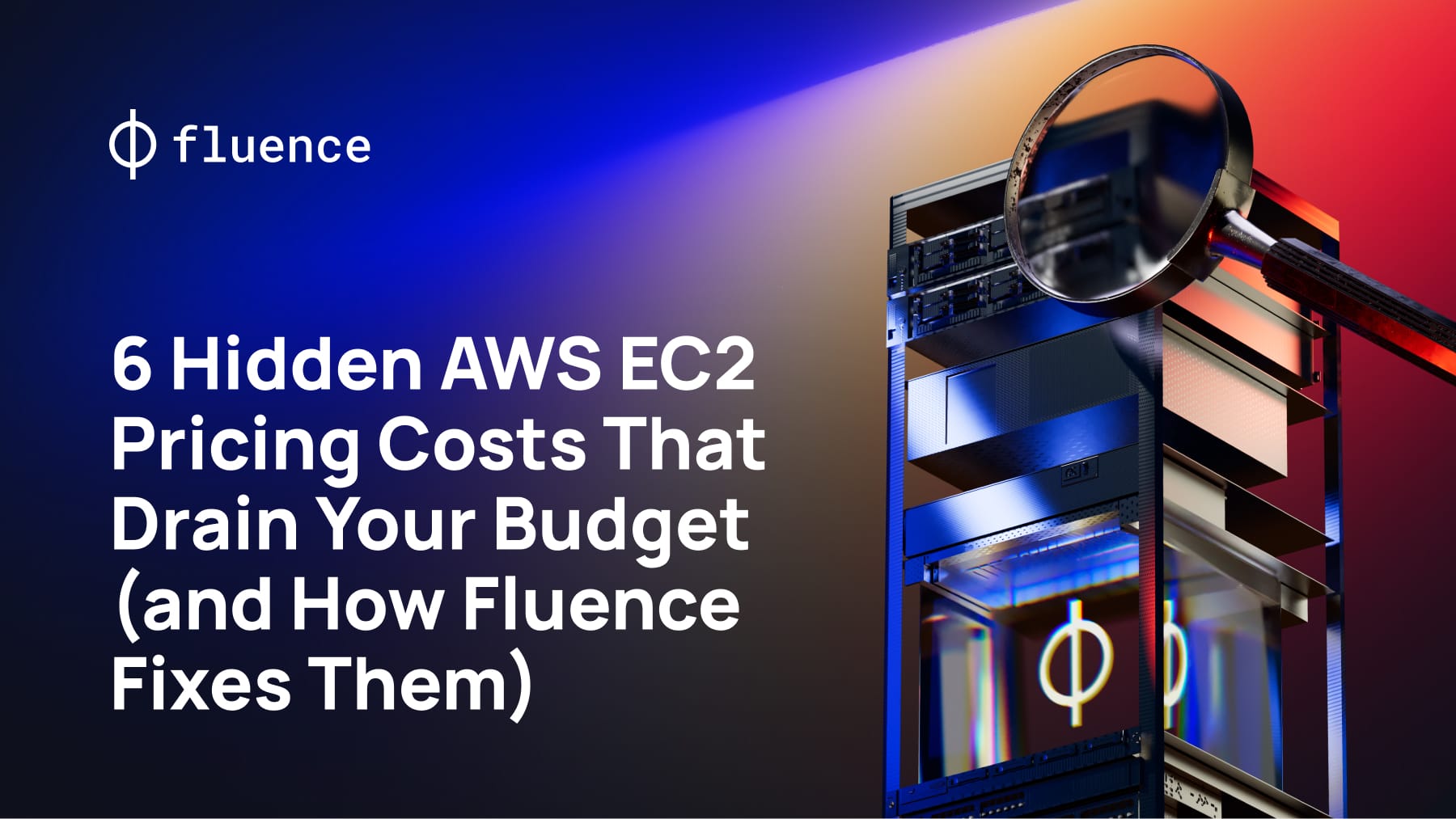6 Hidden AWS EC2 Pricing Costs That Drain Your Budget (and How Fluence Fixes Them)
AWS EC2 pricing hides costly traps like data egress and overprovisioning. This breakdown reveals six hidden fees and compares them to decentralized alternatives like Fluence.

Amazon EC2 dominates the cloud infrastructure market, offering scalability, global reach, and a vast catalog of services. But beneath its flexibility lies a pricing model filled with hidden costs, opaque billing structures, and long-term financial traps. These issues often come to light only after budget overruns, delayed projects, or surprise invoices.
This article outlines six specific hidden AWS fees that frequently go unnoticed and examines their long-term financial consequences. It also introduces Fluence, a decentralized cloud alternative with cost transparency and a design that tackles these systemic pricing challenges.
1. Data Egress Fees: The Unseen Penalty for Growth
AWS charges for outbound data transfer—called data egress—which is one of the most unpredictable and costly aspects of cloud usage. While inbound data is typically free, transferring data out of AWS to the internet or across regions triggers fees that increase with volume.
For example, sending 10 TB of data per month to the internet can cost over $900, depending on the region. These fees burden data-heavy applications such as AI training pipelines, video streaming, or real-time analytics. Internal transfers between services in different regions also add costs, making it more challenging to estimate budgets.
Even moving data between AWS services internally can prompt unexpected charges. This complexity complicates forecasting and discourages distributed architectures.
Fluence avoids these penalties by offering predictable, flat-rate pricing for compute and storage. Data egress carries no extra cost, making it ideal for decentralized apps and high-throughput workloads.
2. API Call Charges and Micro-Usage Accumulation
AWS EC2 API operations (e.g., DescribeInstances, RunInstances) incur no per-request fees, but organizations still face hidden costs when they rely on ancillary services (like S3 for AMIs or CloudWatch for monitoring) alongside EC2. Those services impose per-operation charges that often rise unnoticed as your infrastructure scales.
Listing thousands of S3-hosted AMIs or polling CloudWatch metrics repeatedly can quietly rack up hundreds of dollars each month—costs buried deep in your bill.
Fluence keeps things simple with no per-request fees anywhere in its Cloudless Virtual Server offering, so you pay only for compute usage and never for the API calls that manage your infrastructure.
3. Storage Persistence and Snapshot Bloat
Terminating an EC2 instance doesn't automatically remove associated Elastic Block Store (EBS) volumes or snapshots. These continue accruing charges unless manually deleted. According to CloudChipr, even unattached Elastic IPs cost $0.005 per hour (~$3.60 per month), and standard EBS snapshots are more expensive than archival alternatives.
This leads to “zombie” infrastructure—unused yet still billed. It’s common in development or prototyping scenarios, where instances spin up and down frequently.
Fluence prevents these charges by tying billing to active compute contracts. Once a Cloudless Virtual Server is no longer active, billing halts automatically. No manual cleanup is needed.
4. Autoscaling Surprises and Overprovisioning
AWS Auto Scaling itself is free, but misconfigured minimums or slow scale-down policies can spin up excess EC2 instances during traffic spikes, driving up instance-hour costs unpredictably.
These behaviors are hard to predict, especially for applications with unstable usage. Teams often over-provision to avoid downtime, only to discover they’ve paid for idle servers when traffic subsides.
On the other hand, Fluence’s on-demand model bills only for actual usage time, eliminating hidden autoscaling overages.
5. Reserved Instances and Savings Plans: A Double-Edged Sword
AWS offers Reserved Instances (RIs) and Savings Plans that promise discounts up to 72% compared to on-demand pricing. But these require 1- or 3-year commitments. When your usage patterns shift, you still pay for the unused capacity.
Startups and agile teams risk thousands in wasted commitments when growth or demand changes. These long-term financial commitments reduce the flexibility cloud platforms are meant to provide. As DigitalOcean points out, underutilized capacity eliminates potential savings entirely.
Fluence has no long-term commitments, without requiring you to pre-commit to a certain usage volume. Daily billing aligns directly with real-time demand and agile workflows, enabling more efficient resource planning.
6. Support Fees and Developer Time Loss
AWS offers free basic support, but meaningful SLAs require paid support:
- Developer support starts at $29 per month.
- Business support begins at $100 per month or 10 % of usage, whichever is higher.
Beyond direct fees, managing IAM policies, configuring VPCs, and deciphering detailed billing statements steals developer hours and delays projects.
Fluence reduces this burden through a simpler platform design and community-driven support at no extra cost, so teams spend their time building, not troubleshooting.
Comparative Cost Model: AWS vs. Fluence
Here's a breakdown comparing AWS pricing costs vs Fluence:
Strategic Implications for Cloud Cost Management
AWS’s pricing system builds complexity as organizations grow. As service usage expands, so do interdependencies and billing variability. This raises the barrier to cost optimization without specialized tools or dedicated teams.
Fluence addresses this challenge by removing centralized pricing logic. Transparent rates enforced through smart contracts and predictable costs from decentralized compute nodes reduce the burden on development and finance teams.
For organizations navigating uncertainty, Fluence adds adaptability. Without lock-ins or variable charges, teams scale infrastructure confidently, maintaining cost control during experimentation or rapid growth. This approach is especially relevant for startups, research labs, and innovation-focused units.
Real-World Application: Why Predictability Matters
Take a team developing an AI tutoring system. The project demands real-time inference, persistent data storage, and personalized user sessions. Under AWS, this would span multiple services—EC2, S3, Lambda, CloudWatch, possibly SageMaker—each with complex billing rules.
Unexpected API charges, storage residues, and egress fees could jeopardize timelines and budgets. On Fluence Virtual Servers, the same application runs on rented compute nodes with flat daily fees. There are no per-request charges, and moving data between nodes adds no cost.
This level of cost certainty streamlines engineering work and supports faster iteration without financial surprises.
Conclusion
AWS delivers robust cloud infrastructure, but parts of its pricing model create recurring costs that disrupt engineering speed and strain budgets.
Fluence follows a different model. Its billing is transparent, data egress carries no charge, and there are no long-term commitments. This structure offers an efficient foundation for modern cloud applications.
Teams focused on reliability, financial clarity, and rapid development will find Fluence a strong alternative.
Learn more about Fluence Virtual Servers and experience the cost-efficiency your organization deserves.

